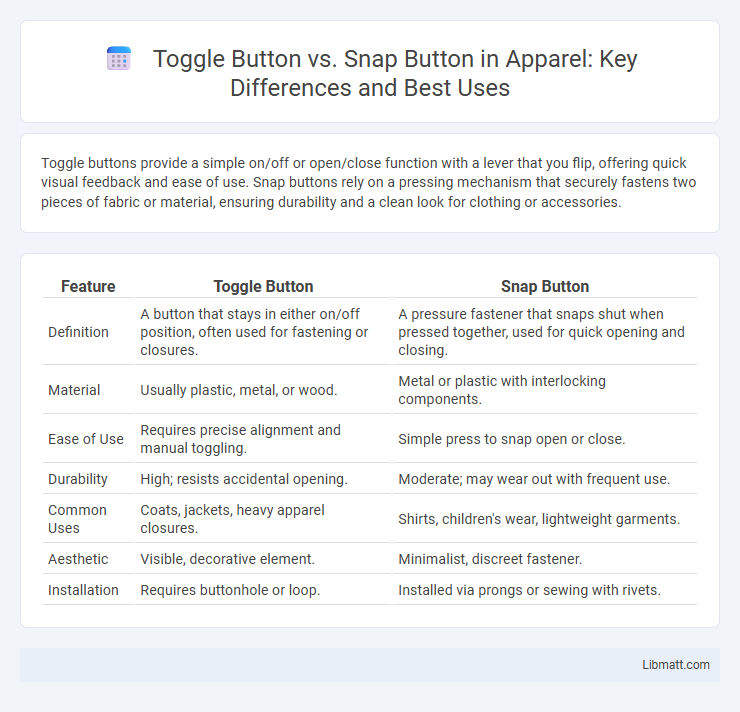Toggle buttons provide a simple on/off or open/close function with a lever that you flip, offering quick visual feedback and ease of use. Snap buttons rely on a pressing mechanism that securely fastens two pieces of fabric or material, ensuring durability and a clean look for clothing or accessories.
Table of Comparison
| Feature | Toggle Button | Snap Button |
|---|---|---|
| Definition | A button that stays in either on/off position, often used for fastening or closures. | A pressure fastener that snaps shut when pressed together, used for quick opening and closing. |
| Material | Usually plastic, metal, or wood. | Metal or plastic with interlocking components. |
| Ease of Use | Requires precise alignment and manual toggling. | Simple press to snap open or close. |
| Durability | High; resists accidental opening. | Moderate; may wear out with frequent use. |
| Common Uses | Coats, jackets, heavy apparel closures. | Shirts, children's wear, lightweight garments. |
| Aesthetic | Visible, decorative element. | Minimalist, discreet fastener. |
| Installation | Requires buttonhole or loop. | Installed via prongs or sewing with rivets. |
Introduction to Toggle and Snap Buttons
Toggle buttons are interactive UI elements that allow users to switch between two states, such as on/off or active/inactive, providing clear visual feedback to indicate the current status. Snap buttons, commonly used in apparel and accessories, consist of two interlocking discs that securely fasten by snapping together, offering a durable and easy-to-use closure method. Both toggle and snap buttons serve distinct functional purposes across digital interfaces and physical products, emphasizing user control and convenience.
Key Differences Between Toggle and Snap Buttons
Toggle buttons maintain their state when pressed, allowing your device to stay on or off until switched again, making them ideal for settings that require consistent feedback. Snap buttons provide momentary contact, clicking back to their original position after being pressed, commonly used for quick, temporary actions. Key differences lie in their operation style--toggle buttons offer sustained engagement, while snap buttons enable transient input for precise control.
Design and Appearance Comparison
Toggle buttons feature a sliding mechanism that visually indicates on/off states with a smooth, elongated design, making them ideal for modern, touch-friendly interfaces. Snap buttons consist of two interlocking discs, often metallic or plastic, providing a tactile and durable fastener commonly used in clothing and accessories. The sleek, minimal aesthetic of toggle buttons contrasts with the utilitarian and sturdy appearance of snap buttons, influencing their application based on visual preferences and functional requirements.
Durability and Strength Analysis
Toggle buttons offer superior durability due to their solid construction and resistance to wear, making them ideal for heavy-duty applications. Snap buttons, while convenient for quick fastening, often experience reduced strength over time as the spring mechanism weakens. Evaluating Your project's longevity needs will help determine whether toggle buttons or snap buttons provide the optimal balance of strength and durability.
Ease of Use and Application
Toggle buttons offer intuitive ease of use by providing a clear on/off state, making them ideal for applications requiring quick binary choices such as light switches and power controls. Snap buttons deliver rapid fastening and unfastening through a mechanical grip, commonly used in clothing and accessories where secure closure and frequent access are necessary. Both types excel in user-friendly design, with toggles favored for electronic interfaces and snaps preferred in textile and wearable applications.
Common Uses in Fashion and Accessories
Toggle buttons are frequently used in outerwear like duffle coats and chunky knitwear due to their easy-to-fastened design and decorative appeal, often made from wood or horn for a rustic look. Snap buttons are popular in casual wear and accessories such as denim jackets, bags, and wallets, providing quick, secure fastening ideal for active use. Your choice depends on whether you prioritize aesthetic charm with toggles or practical convenience with snap buttons in fashion and accessories.
Installation Methods and Tools Required
Toggle buttons typically require sewing tools such as needles, thread, and sometimes a thimble for manual installation, or a sewing machine for faster attachment to fabric. Snap buttons demand specialized tools like snap pliers or a press machine to securely fasten the male and female parts, ensuring a durable closure. Both installation methods vary in complexity, with toggle buttons relying on stitching skills, while snap buttons depend on mechanical fastening tools.
Cost Comparison: Toggle vs Snap Buttons
Snap buttons typically offer a lower cost per unit compared to toggle buttons due to simpler manufacturing processes and widespread availability, making them a budget-friendly choice for mass production. Toggle buttons often require more intricate materials and assembly, which increases their price but provides enhanced durability and a unique aesthetic. Your decision between toggle and snap buttons should consider both the initial cost and the long-term value each type provides in your specific application.
Maintenance and Longevity
Toggle buttons typically offer easier maintenance because their simple design allows for straightforward cleaning and fewer mechanical failures, extending their usability in various applications. Snap buttons, while offering a secure closure, may wear out more quickly due to repeated snapping and unsnapping, requiring periodic replacement to maintain functionality. Your choice between toggle and snap buttons can significantly impact the longevity and upkeep effort depending on the intended use and frequency of operation.
Choosing the Right Button for Your Project
Choosing the right button for your project depends on functionality and design preferences. Toggle buttons provide a clear on/off state, ideal for user input that requires enabling or disabling features, while snap buttons offer a secure fastening solution often used in clothing and accessories. Consider the user interaction and aesthetic requirements to ensure the button enhances both usability and style.
Toggle Button vs Snap Button Infographic

 libmatt.com
libmatt.com